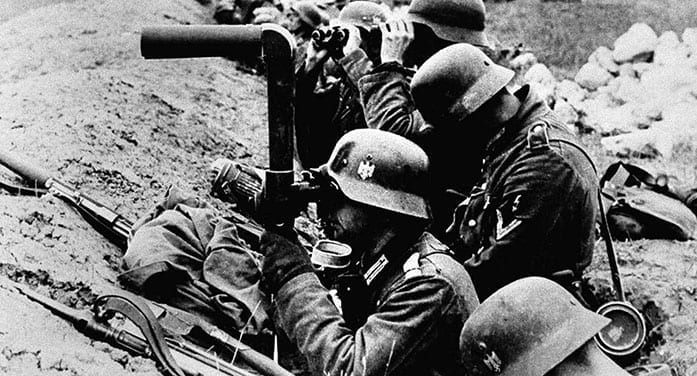 Adolf Hitler launched the German invasion of the Soviet Union – Operation Barbarossa – in the early hours of June 22, 1941. Initially, it looked like a triumph.
Adolf Hitler launched the German invasion of the Soviet Union – Operation Barbarossa – in the early hours of June 22, 1941. Initially, it looked like a triumph.
The Soviets were caught flatfooted and German troops advanced 480 km into Soviet territory within the first week. It looked like an eastern version of the blitzkrieg that flattened Western Europe in the spring of 1940.
In reality, though, it was the first of two fateful mistakes Hitler made in 1941. The other came six months later when, in the immediate aftermath of Japan’s attack on Pearl Harbour, he declared war on the United States.
Hitler had effectively put himself in a no-win position. To quote from an earlier column of mine (Nov. 30, 2017): “Taken together, the combined population of the United States, the Soviet Union and Britain was more than double that of Germany and its Italian and Japanese allies. And with the United States in the war, its industrial resources generated a continuous flow of the materials needed to win an all-out 20th-century conflict.”
Soviet leader Josef Stalin was flabbergasted by Operation Barbarossa, so much so that he went into a two-day funk, disappearing from the Kremlin and taking himself off to his dacha. The world was unfolding in a manner radically at odds with his expectations.
Stalin was realistic enough to realize that his 1939 pact with Hitler wouldn’t last indefinitely. If nothing else, Soviet territory was a prime target for Hitler’s announced policy of Lebensraum, the quest for land and resources in the east.
But Stalin thought he understood how Hitler’s mind worked.
Hitler, in Stalin’s assessment, was a rational man. He would never attack the Soviet Union while the war in the west was unresolved. Choosing to fight on two fronts would be stupid.
Consequently, Stalin’s approach was to play for time. While avoiding provocation and continuing the delivery of trade goods to the Germans, the Soviets would quietly build their forces in preparation for the inevitable attack. Hopefully, it could be deferred to 1942. Or maybe even 1943.
Meanwhile, Stalin swept aside the numerous intelligence reports warning of an imminent invasion. They were, he thought, disinformation.
Not only that, but perhaps the reports were a British plot to ensnare the Soviets in an anti-German alliance. For someone with Stalin’s paranoid leanings, that would’ve seemed a highly logical inference.
So was Stalin responsible for the Soviet Union’s predicament in the summer of 1941?
The answer is complicated.
During the Great Terror of 1937-38, over 34,000 officers were purged from the armed forces and thousands were shot. As historian Ian Kershaw succinctly put it, “Higher ranks suffered disproportionately in the decapitation of the Red Army. Of the 101 members of the supreme military leadership, 91 were arrested, and of these 80 shot.”
This was a major contributor to the sorry state of Soviet forces at the time of Operation Barbarossa. And it was Stalin’s doing. His paranoia was the primary driver.
Indeed, Stalin never lost his penchant for executing his own officers. In the catastrophic early days of the German invasion, he had eight generals shot.
Then there’s the 1939 pact with Germany, which Stalin perceived as a masterstroke. But was it?
Yes, it bought breathing space and territorial gains. However, it also freed Hitler to invade Poland and then turn west without worrying about hostile Soviet action on his eastern front.
Stalin can also be held responsible for the toxic political culture in the Soviet Union, which rendered any form of disagreement with him dangerous, even potentially fatal. This produced an environment where people told him what he wanted to hear. Kershaw’s word for it is “toadying.”
Granted, many organizations are susceptible to this. But when the possible consequences include your life, the inducement to go along is incomparably higher.
Assessing responsibility gets more complicated as the calendar shifts to 1940-41. By that time, Stalin’s practical options had drastically narrowed.
The sudden and unanticipated collapse of France changed the equation. Hitler was now dominant in Western Europe and the Soviet Union was in a box, and the lid was about to close. Even if Stalin hadn’t been prone to self-delusion, the Soviet Union was running out of road.
For both Stalin and Hitler, the reality of Operation Barbarossa beckoned. It was to be a very rough ride.
Troy Media columnist Pat Murphy casts a history buff’s eye at the goings-on in our world. Never cynical – well, perhaps a little bit. For interview requests, click here.
The views, opinions and positions expressed by columnists and contributors are the authors’ alone. They do not inherently or expressly reflect the views, opinions and/or positions of our publication.
© Troy Media
Troy Media is an editorial content provider to media outlets and its own hosted community news outlets across Canada.


